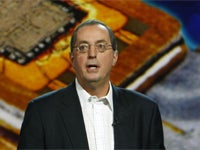 |
| Intel CEO Paul Otellini at CES 2008. Source: Intel |
After causing a one-day scare on Wall Street in March with a warning that its margins would suffer from the NAND flash oversupply, Intel ended up delivering a fairly decent quarter after all.
Intel (NASDAQ: INTC) even managed to pull out respectable numbers despite seasonal weakness, the flash memory oversupply and concerns about the U.S. economy.
For the quarter ended March 29, Intel reported a net profit of $1.44 billion, or 25 cents per share. That’s a 12 percent decline from the same quarter one year ago, but in line with the average estimate of analysts polled by Thomson Financial.
Revenue for the quarter was $9.7 billion, a 9 percent increase over Q107 but a 10 percent dip from Q407, representing a typical seasonal decline.
The only real negative impact Intel faced during the quarter came from the spinoff of its NOR
Intel took a restructuring and asset impairment charge of $275 million in impairment charges for the assets transferred to Numonyx.
“Nothing seems drastically out of the ordinary here,” Jim McGregor, senior analyst with In-Stat, told InternetNews.com. “Everything looks quite in line … they’ve noted some restructuring charges, which has to do with the spin off of the memory unit.”
“If you look at this, other than Numonyx, they seem to be on a growth path,” he said.
During a conference call with financial analysts, Intel CEO Paul Otellini said the first quarter marked “a very good start to 2008,” and pointed to Intel’s payout of a record dividend and its buyback of $2.5 billion in stock.
More importantly, Otellini said, sales were increasing in each regions in which the company does business — especially in North America, which grew 17 percent year-over-year.
Otellini added that supply and demand were healthy and in balance, with server sales particularly strong, particularly in the multiprocessor segment, thanks to the Caneland platform it released last year.
He also said that mobile processor sales were so strong that Intel now predicts mobile computers will surpass desktop computer sales this year — not in 2009, as it originally forecasted.
Otellini also said Intel is taking steps to address its troublesome flash memory business.
“We’re making decisions on capacity to mitigate oversupply of NAND,” he said during the call. “I want to assure our shareholders we entered this business to make money and will make appropriate decisions to that end.”
Intel’s chief financial officer, Stacy Smith, said the NAND flash market’s oversupply had been partially due to Intel, which added a new plant.
However, the company has since delayed opening a Singapore facility with Micron as it looks at how to restore some supply and price balance to the market, she said.
Otellini also discussed other efforts to examine its cost structure, which he said continues to improve. For instance, he said that during the quarter, Intel reduced its headcount by another 1,700 employees, to 85,000.
“Our production costs will decline over 2008, which suggests margin expansion over the year,” he added.
The company projects a gross margin of 56 percent in the second quarter and 57 percent for the year — numbers that In-Stat’s McGregor liked.
“That tells me they are feeling very comfortable about the outlook for the rest of the year,” he said. “They struggled with it during their down period in previous years when they were behind, but they have brought margins back to where Wall Street expects them.”
For the quarter ahead, Intel executives projected revenues of between $9 and $9.6 billion, a slight decrease due to sales lost from the spinoff of the NOR business to Numonyx.
Expenses will be between $2.8 billion and $2.9 billion and the company gave guidance of another hit from restructuring and asset impairment charges — this time approximately $250 million.


